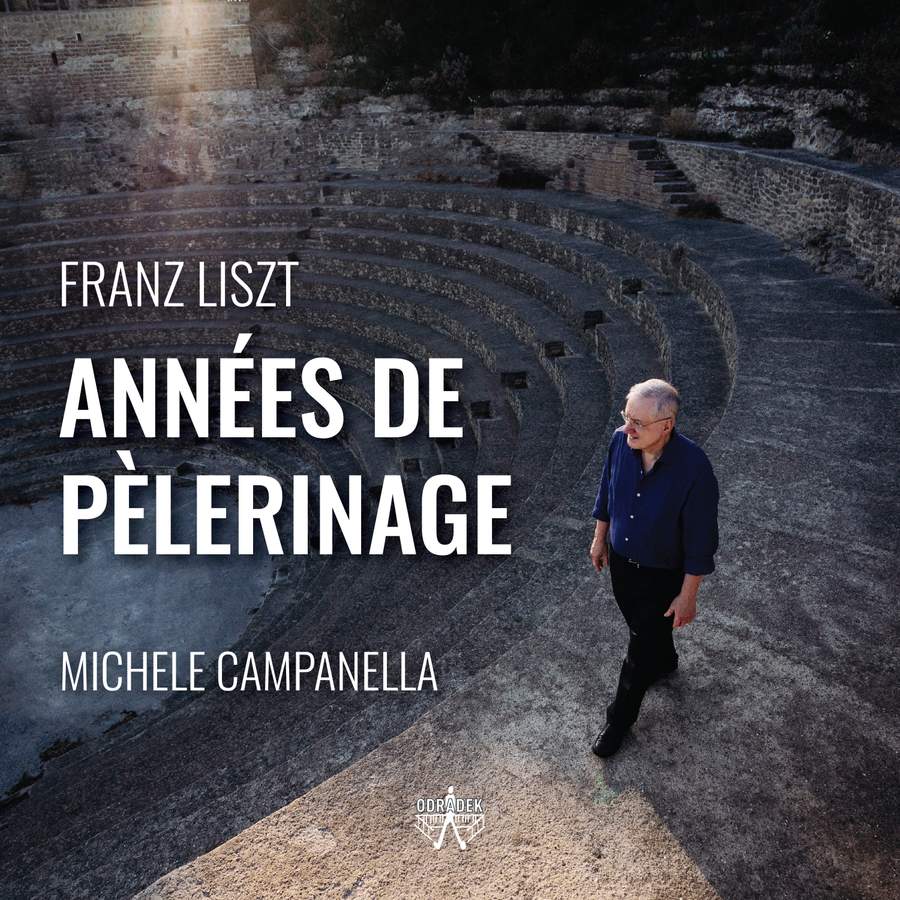LISZT Années de pèlerinage (Michele Campanella)
View record and artist detailsRecord and Artist Details
Genre:
Instrumental
Label: Odradek
Magazine Review Date: 02/2021
Media Format: CD or Download
Media Runtime: 154
Mastering:
DDD
Catalogue Number: ODRCD391

Tracks:
| Composition | Artist Credit |
|---|---|
| Années de pèlerinage année 1: Suisse |
Franz Liszt, Composer
Michele Campanella, Piano |
| Années de pèlerinage année 2: Italie |
Franz Liszt, Composer
Michele Campanella, Piano |
| Années de pèlerinage année 3 |
Franz Liszt, Composer
Michele Campanella, Piano |
Author: Patrick Rucker
Throughout his career, Michele Campanella, the Neapolitan pianist now in his 74th year, has been identified with the music of Liszt. In the early 1970s he recorded a set of Hungarian Rhapsodies (reissued by Philips, 8/93), and the Hungarian Fantasy and Totentanz with the Monte Carlo Opera Orchestra under Aldo Ceccato (5/72). More recently, Campanella has been one of the growing number of pianists to record Liszt on 19th-century instruments. For a 2011 recording of late works, he used an 1860 Bechstein (Brilliant Classics). A programme of the Wagner transcriptions was recorded at the Villa Wahnfried in 2012 on Wagner’s own 1876 Steinway. For his first recording of the Années de pèlerinage, Campanella has chosen an 1892 Steinway from the collection of Roberto Valli.
The gem of this three-disc set is the second Année. Campanella’s straightforward approach to ‘Sposalizio’, Liszt’s evocation of Rafael, strikes just the right balance between devotion and poetry. ‘Il penseroso’ speaks with simple directness, with strong harmonic direction shaping its dark atmosphere. Campanella’s little Salvator Rosa song is less spirited than most, though its relatively relaxed tempo is nonetheless effective. The three Petrarch Sonnets are vividly individual and so rhetorically apt that one can easily imagine them sung. In ‘Pace non trovo’ Campanella eschews melodrama in favour of a spacious metric stability, lending an air of grandeur, and it’s difficult to think of a more touchingly intimate reading of ‘I’ vidi in terra angelici costumi’. The same sure tread Campanella exhibits in the Sonnets serves him well in the greater complexities of the ‘Dante Sonata’. Unrushed and far from histrionic, the performance radiates clarity, abetted by the quicker decay of the 1892 Steinway. If there are moments when one might wish for greater elasticity of phrase or a more passionate forward impetus, in its own Apollonian terms this is a beautifully realised conception. What a pity that Campanella, himself a Neapolitan, chose not to record the supplement to the second Année which Liszt published three years later, Venezia e Napoli.
Unfortunately, Campanella’s Swiss Year is less assured. Following a stolidly stentorian ‘Chapelle de Guillaume Tell’, the placid ‘Au lac de Wallenstadt’ seems oddly moribund, the freshness of its melody and open harmonies collapsing under a lethargic tempo. The gentle rocking rhythm of ‘Pastorale’ is more plausible, though its deliciously quirky contrasting section comes across as anaemic. The metronomic pulse that pervades ‘Au bord d’une source’ leaves the impression of a whirligig rather than a bubbling Alpine spring. Campanella’s judicious pedalling works well with the instrument’s less than booming bass in providing a corrective to the sonic onslaught that is so often ‘Orage’. Strangely, however, shortly before the end of the piece, Campanella expands Liszt’s four-bar rallentando to 14 bars. Did this furious Alpine storm suddenly make a quick rest stop before roaring back and dumping tons of snow over everything in sight? On the other hand, ‘Vallée d’Obermann’, save for a few moments when momentum threatens to stall completely, is noble in concept and execution. Overly cautious tempos, vague articulation and lacklustre sound rob ‘Eglogue’ of its playfulness and ‘Le mal du pays’ of its pathos. Things rally in an atmospheric ‘Les cloches de Genève’, pulling together some if not all of the purposeful loose ends that have preceded it.
If the first Année is ‘about’ nature and the second ‘about’ art, the third Année, published a quarter of a century after its predecessor, could be described as ‘monuments’. Though it presents fewer purely technical challenges than the first two Années, its musical and conceptual challenges are nonetheless formidable. Apart from a seasoned and persuasive ‘Les jeux d’eaux’, the rest of the cycle seems lacking in focus and empathy. Some see Liszt’s late works as defoliation; others argue that they represent a distillation of essences. It’s unclear where Campanella stands.
When Lazar Berman’s 1977 Années de pèlerinage appeared (DG, 12/77, 11/93), they created a sensation. It may be Alfred Brendel who has, through performances as well as various audio and video recordings, wielded greatest influence over perceptions of Liszt’s masterpiece. Of the recordings that appeared during the 2011 bicentennial, those of Bertrand Chamayou (Naïve, 3/12) and Louis Lortie (Chandos, 6/11) are standouts. Against these, and despite the fine qualities of his Deuxième année, Campanella faces some heavy headwinds.
Explore the world’s largest classical music catalogue on Apple Music Classical.
Included with an Apple Music subscription. Download now.

Gramophone Digital Club
- Digital Edition
- Digital Archive
- Reviews Database
- Events & Offers
From £9.20 / month
Subscribe
Gramophone Club
- Print Edition
- Digital Edition
- Digital Archive
- Reviews Database
- Events & Offers
From £11.45 / month
Subscribe
If you are a library, university or other organisation that would be interested in an institutional subscription to Gramophone please click here for further information.






